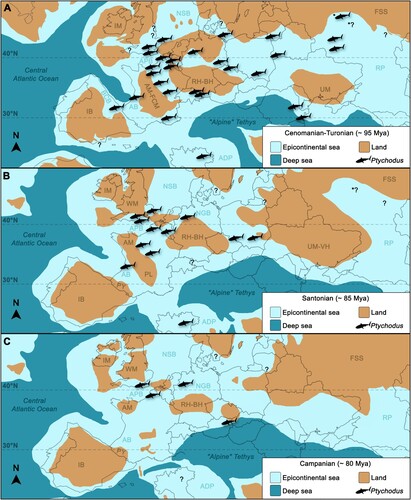Figures & data
FIGURE 1. Locality maps showing approximate area of European Russia (A) with localities where Ptychodus has been hitherto reported (n.1–5), the Central Federal District (B), and the Ryazan Oblast (C; black star, Malyy Prolom quarry).
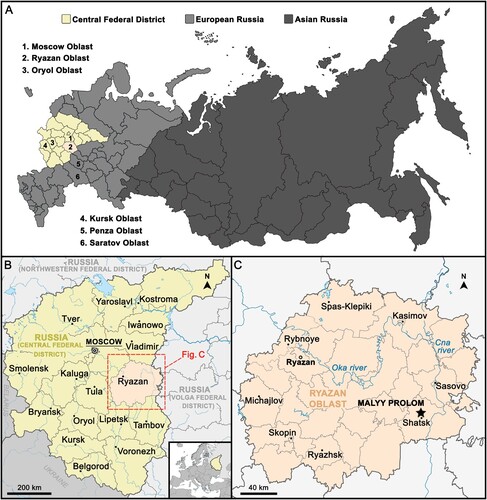
FIGURE 2. Mesozoic sedimentary strata (A; black star, Malyy Prolom quarry) and the stratigraphic column (B) depicting the Yakhroma and Dmitrov Formations sedimentary succession and fossil bearing horizon within the Malyy Prolom quarry exposure (modified after Solonin et al., Citation2021b).
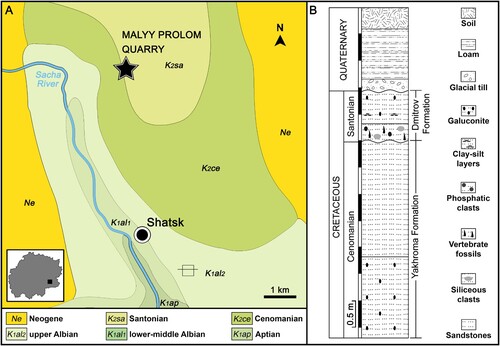
FIGURE 3. Teeth of Ptychodus altior Agassiz, Citation1835, from the Upper Cretaceous of Ryazan Oblast (western Russia) in occlusal (A, B, C, D, E, F), anterior (AI, BI, DI, EI), posterior (CI, FI), lateral (AII, BII, CII, EII, FII), and inferior (AIII) views. A–AIII, RSU DGE 2018 RO MP-47; B–BII, RSU DGE 2020 RO MP-5; C–CII, RSU DGE 2020 RO MP-8; D, DI, RSU DGE 2020 RO MP-9; E–EII, RSU DGE 2020 RO MP-17; F–FII, RSU DGE 2021 RO MP-1. Scale bars equal 5 mm.
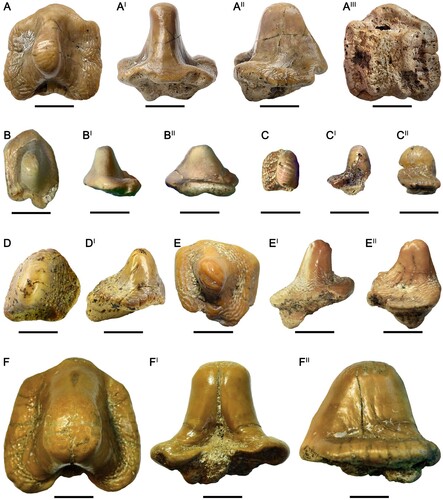
FIGURE 4. Teeth of Ptychodus anonymus Williston, Citation1900a, from the Upper Cretaceous of Ryazan Oblast (western Russia) in occlusal (A, B, C, D, E, F, G, H), anterior (AI, BI, CI, DI, EI, FI), posterior (AII, GI, HI), lateral (AIII, BII, DII, EII, EIII, GII, HII), and inferior (BIII, CII, GIII, HIII) views. A–AIII, RSU DGE 2018 RO MP-42; B–BIII, RSU DGE 2020 RO MP-20; C–CII, RSU DGE 2020 RO MP-3; D–DII, RSU DGE 2021 RO MP-21; E–EIII, RSU DGE 2020 RO MP-14; F, FI, RSU DGE 2021 RO MP-25; G–GIII, RSU DGE 2021 RO MP-8; H–HIII, RSU DGE 2021 RO MP-9. Scale bars equal 10 mm.
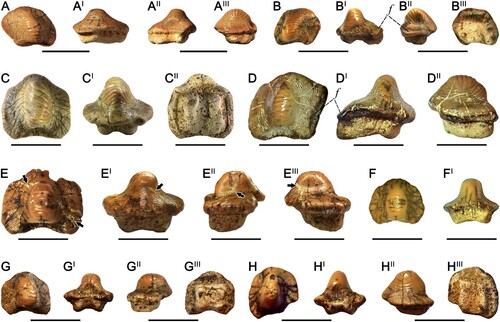
FIGURE 5. Teeth of Ptychodus decurrens Agassiz, Citation1837, from the Upper Cretaceous of Ryazan Oblast (western Russia) in occlusal (A, B, C, D, E, F, G), anterior (AI, FI), posterior (AII, BI, DI, FII, GI), lateral (AIII, CI, EI, FIII, FIV, GII), and inferior (AIV, BII, DII, GIII) views. A–AIV, RSU DGE 2020 RO MP-10; B–BII, RSU DGE 2020 RO MP-11; C–CI, RSU DGE 2020 RO MP-21; D–DII, RSU DGE 2021 RO MP-4; E–EI, RSU DGE 2021 RO MP-6; F–FIV, RSU DGE 2021 RO MP-11; G–GIII, RSU DGE 2021 RO MP-13. Scale bars equal 5 mm.

FIGURE 6. Tooth (A–AIV, SS106-1) of Ptychodus latissimus Agassiz, Citation1835, from the Upper Cretaceous of Ryazan Oblast (western Russia) in occlusal (A), anterior (AI), posterior (AII), lateral (AIII), and inferior (AIV) views. Scale bars equal 10 mm.

FIGURE 7. Teeth of Ptychodus mammillaris Agassiz, Citation1835, from the Upper Cretaceous of Ryazan Oblast (western Russia) in occlusal (A, B, C, D, E, F, G), anterior (CI, DI, GI), posterior (AI, BI, CII, DII, EI, FI, GII), lateral (AIII, CIII, DIII, EII, FII, GIII), and inferior (EIII, FIII) views. A–AIII, RSU DGE 2020 RO MP-6; B–BI, RSU DGE 2020 RO MP-12; C–CIII, RSU DGE 2021 RO MP-2; D–DIII, RSU DGE 2021 RO MP-14; E–EIII, RSU DGE 2021 RO MP-20; F, FIII, SS106-4; G–GIII, SS106-7. Scale bars equal 10 mm.
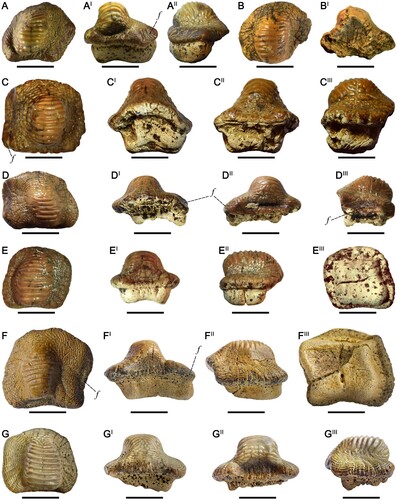
FIGURE 8. Teeth here assigned to Ptychodus marginalis sensu Hamm (Citation2020a) from the Upper Cretaceous of Ryazan Oblast (western Russia) in occlusal (A, B), anterior (AI, BI), posterior (AII), lateral (AIII, AIV, BII), and inferior (BIII) views. A–AIV, SS106-2; B–BIII, SS106-3. Scale bars equal 5 mm.
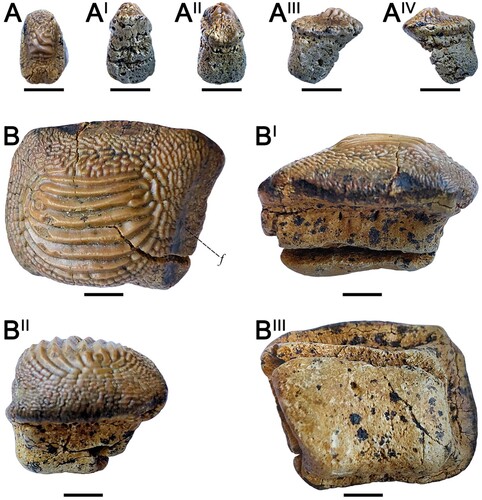
FIGURE 9. Tooth (A–AIV, RSU DGE 2021 RO MP-10) here assigned to Ptychodus sp. cf. P. mediterraneus Canavari, Citation1916, from the Upper Cretaceous of Ryazan Oblast (western Russia) in occlusal (A), anterior (AI), posterior (AII), lateral (AIII), and inferior (AIV) views. Scale bars equal 10 mm.

FIGURE 10. Teeth of Ptychodus polygyrus Agassiz, Citation1835, from the Upper Cretaceous of Ryazan Oblast (western Russia) in occlusal (A, B), anterior (AI, BI), posterior (AII, BII), and lateral (AIII, BIII) views. A–AIII, RSU DGE 2018 RO MP-41; B–BIII, RSU DGE 2021 RO MP-19. Scale bars equal 5 mm.
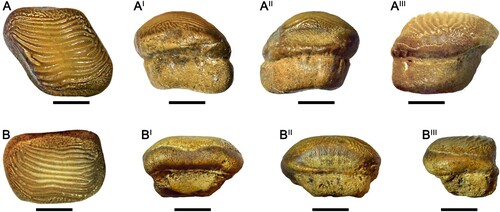
TABLE 1. Taxonomic composition of Ptychodus from the Upper Cretaceous of various European localities. Abbreviations: BE, Belgium; C, cuspidate taxon; C-IT, central Italy; C-LT, central Lithuania; C-RO, central Romania; DK, Denmark; E-AT, eastern Austria; E-DE, eastern Germany; N-CH, northern Switzerland; N-CZ, northern Czech Republic; N-FR, northern France; N-IT, northern Italy; S-EN, southern England; S-ES, southern Spain; S-FR, southeastern France; S-IT, southern Italy; S-SE, southern Sweden; S-PL, southern Poland; UC, un-cuspidate taxon; W-DE, western Germany; W-FR, western France. See Table S3 for more details.
TABLE 2. Taxonomic composition of Ptychodus from the Upper Cretaceous of five Russian localities (asterisk indicates species described in the present study). Abbreviations: C, cuspidate taxon; UC, un-cuspidate taxon.
FIGURE 11. European localities that yielded teeth of Ptychodus (A) with a comparison between the species richness (B) between main fossiliferous areas (BE, Belgium; C-IT, central Italy; C-LT, central Lithuania; C-RO, DK, Denmark; central Romania; E-AT, eastern Austria; E-DE, eastern Germany; KO, Kursk Oblast, Russia; MO, Moscow Oblast; N-FR, northern France; N-CH, northern Switzerland; N-CZ, northern Czech Republic; N-IT, northern Italy; OO, Oryol Oblast; RO, Ryazan Oblast; S-ES, southern Spain; S-EN, southern England; S-FR, southeastern France; S-IT, southern Italy; S-PL, southern Poland; S-SE, southern Sweden; SO, Saratov Oblast; W-DE, western Germany; W-FR, western France; see also Tables 1 and 2, and Tables S3 and Table S4 in Supplemental Data. Asterisks indicate the areas from which the material examined in this study comes. 1, western Pyrenees (Spain); 2, Ferriol-Elche (Spain); 3, Yorkshire (England); 4, Lincolnshire (England); 5, Suffolk, Norfolk, Essex (England); 6, Bedfordshire, Hertfordshire, Buckinghamshire (England); 7, Sussex, Surrey, Kent, Greater London (England); 8, Isle of Wight, Hampshire, Wiltshire, Dorset (England); 9, Devon (England); 10, Normandy (France); 11, Hauts-de-France (France); 12, Grand Est (France); 13, Pays de la Loire (France); 14, Centre-Val de Loire (France); 15, Bourgogne-Franche-Comté (France); 16, New Aquitaine (France); 17, Auvergne-Rhône-Alpes (France); 18, Provence-Alpes-Côte d’Azur (France); 19, Hainaut, Namur (Belgium); 20, Westphalia (Germany); 21, Saxony (Germany); 22, Úpohlavy (Czech Republic); 23, Benátky nad Jizerou, Březina, Lysá nad Labem (Czech Republic); 24, Oberriet, St. Gallen (Switzerland); 25, Vorarlberg (Austria); 26, Vienna (Austria); 27, Veneto (Italy); 28, Emilia-Romagna (Italy); 29, Tuscany (Italy); 30, Marche (Italy); 31, Sicily (Italy); 32, Oretorp (Sweden); 33, Annetorp (Sweden); 34, Bornholm Island (Denmark); 35, Wyszki (Poland); 36, Opole, Włodzienin (Poland); 37, Glanów, Mydlniki, Sobkow (Poland); 38, Kaunas, Skirsnemunė (Lithuania); 39, Brèst (Belarus); 40, Ormeniş (Romania); 41, Peştera (Romania); 42, Moscow Oblast (Russia); 43, Ryazan Oblast (Russia); 44, Oryol Oblast (Russia); 45, Kursk Oblast (Russia); 46, Saratov Oblast (Russia).
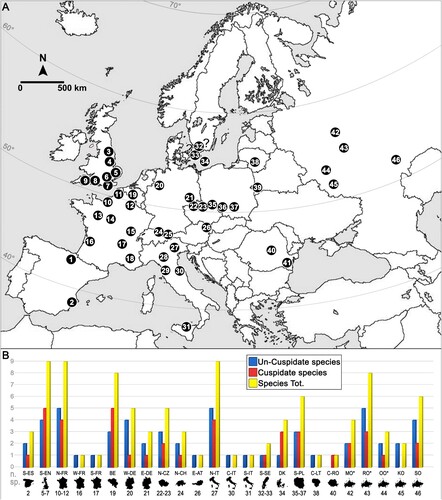
FIGURE 12. Lower Cretaceous paleogeographic maps with occurrences of Ptychodus from the Albian of Clansayes (Auvergne-Rhône-Alpes region, southern France; modified from Granier, Citation2017; see also Table S3 and Table S4 in Supplemental Data).
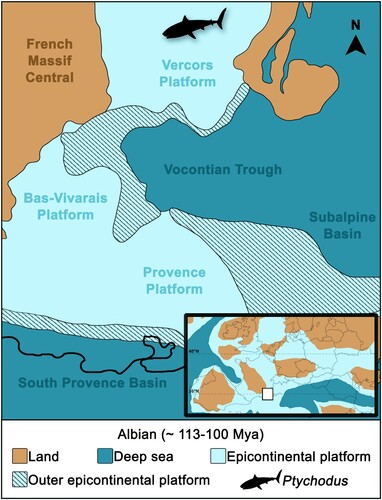
FIGURE 13. Upper Cretaceous paleogeographic maps (coastlines based on Neubauer and Harzhauser, Citation2022; modified from Puértolas-Pascual et al., Citation2016) with Cenomanian–Turonian (A), Santonian (B), and Campanian (C) occurrences of Ptychodus in Europe (see also Table S3 and Table S4 in Supplemental Data). Asterisks indicate the areas from which the material examined in this study comes. Question marks indicate occurrences with uncertain age. Abbreviations: AB, Aquitaine Basin; ADP, Adria Platforms; APB, Anglo-Paris Basin; AM, Armorican Massif; BCB, Basque-Cantabrian Basin; IB, Iberia; IM, Irish Massif; FCM, French Massif Central; FSS, Fenno-Scandian Shield; NGB, North German Basins; NSB, North Sea Basin; PL, Provencal Landmass; PY, Pyrenean Landmass; RH-BH, Rhenish-Bohemian High; RP, Russian Platform; UM-VH, Ukrainian Massif-Voronezh High; WM, Welsh Massif.
